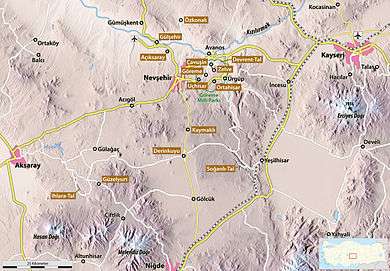Ortahisar, Nevşehir
Ortahisar (Turkish: Central Castle) is a small town in Ürgüp district of Nevşehir Province, in Cappadocia, Turkey. Ortahisar has 14,262 inhabitants as of 2015 and is located about 20 km east of the provincial capital, Nevşehir.
Ortahisar | |
|---|---|
Town | |
.jpg) View of Ortahisar | |
 Ortahisar | |
| Coordinates: | |
| Country | Turkey |
| Region | Central Anatolia Region |
| Province | Nevşehir |
| District | Ürgüp |
| Government | |
| • Mayor | İsmail Genç (MHP) |
| Elevation | 1,200 m (3,900 ft) |
| Population (2015)[1] | |
| • Total | 14,262 |
| Website | www |
Description and landmarks

The entire town is dominated by the 90-metre-high (300 ft) rock-castle in the centre of the town, which is called Sivrikoya by the inhabitants. It is an extraordinary example of the rock-cut architecture which is typical of the region and served as a refuge from attackers in Byzantine times. The town also contains the Cambazlı Kilise ('Church of Acrobats'), a cross-in-square church with 13th-century wall paintings which is now used as a storehouse. A little outside there is a fairy chimney which contains the Üzümlü kilise ('Grapevine Church') from the 8th or 9th century AD. It contains frescoes with grapevines and an image of Mary enthroned with the baby Jesus in the apse.
Aside from the rock-cut buildings in the centre of the town, Ortahisar is characterised by a series of simply constructed structures. These buildings are similar in design and rough in appearance. The upper houses are made of blocks of tuff, mostly without mortar. These buildings which were only used for the storage of food in earlier times, are generally only one or two stories high. The upper floor is often accessed by an exterior staircase made of tuff-stone slabs. The more recent buildings are all made from the same kind of stone, but have are made of regular blocks. The exterior walls are covered with white limestone and capped with simple cornices.[2]
Northeast of Ortahisar is the monastery complex of Hallaç Manastırı. This complex is centred on a courtyard which is closed on three sides, but open to the south. The gathering of dust and stone over time means that the ground level is one and a half metres higher than it was when the structure was built, so the entrances to the rooms of the monastery are lower than the courtyard. Since the monastery was abandoned, locals have walled up the entrances and lined the windows with coloured paint, in order to use them as dovecotes for the production of guano as fertiliser. Also near the town are the Sarica and Harum churches.
Economy
Ortahisar is the centre of fruit production in Cappadocia. The tuff-stone holes in the area, which have a constant temperature of 10 °C in summer and winter, were used to store fruit and vegetables, including those produced elsewhere. Citrus fruits, potatoes, apples and onions from the whole of Turkey were brought there, stored in the holes and transported onwards later on. Large parts of Turkey, including the European region, were supplied from the place.
References
| Wikimedia Commons has media related to Category:Ortahisar. |
| Wikivoyage has a travel guide for Ortahisar, Nevşehir. |
- Yerelnet, accessed 16 February 2016
- Kappadokien. Casa Editrice Bonechi, Florence (1996) p. 11.
Bibliography
- Peter Daners, Volker Ohl, Kappadokien. Dumont, 1996, ISBN 3-7701-3256-4.
- Michael Bussmann/Gabriele Tröger, Türkei. Michael Müller Verlag 2004 ISBN 3-89953-125-6.
- Marianne Mehling (ed.), Knaurs Kulturführer in Farbe Türkei. Droemer-Knaur 1987 ISBN 3-426-26293-2.